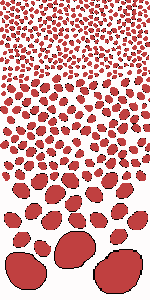Soil is the outer covering of the planet, and the basis of our gardens. What our soil is like affects what we can grow and how well plants do in our particular garden. Unless we grow all our plants in containers where we can choose what we grow them in, we have to adapt our expectations to the soil we find in our gardens.
WHAT IS SOIL MADE OF?
Initially, all over the planet, small pieces of rock broke off mountains and fell, breaking into smaller pieces as they went, so that at the bottom of mountains, heaps of rocks, stones and dust formed. Plants were able to take root in this, and when these plants died and decayed they added to the pockets of soil. Eventually, much of the planet was covered in soil, its exact composition determined partly by the type of rock in the area and by the local weather conditions.
So all soil is composed of small pieces of the local rock and decayed vegetable or animal matter. The rock particles are classified on the basis of their size:
CLAY is the smallest particles of broken rock in soil, less than .0002mm in diameter, so it is a fine dust. When wet, the individual particles stick together to form a solid mass. When they dry, they can bake to a hard crust. Clay holds water which does not drain away.
SILT is slightly larger pieces of rock than clay. It is also soft and smooth, with individual pieces close together. It too holds a lot of water, but the slightly larger particles make it a little better at draining than clay. Silt is often found in river estauries, because the fine particles are washed downstream and deposited when the water flows more slowly.
SAND is small pieces of rock (2mm to .05mm diameter) such as quartz or sandstone. Sand particles are large enough to allow water to drain easily, but they do not hold water and are easily blown around when dry.
STONES, ROCKS AND BOULDERS are larger pieces of rock which are too big to form part of the soil but are found in many gardens. Under the surface layer of soil, they can help drainage.
As well as rock, soil contains organic material, formed from decayed plants or animals. There are two main types of vegetation in soil:
HUMUS is completely decayed matter. It forms a soft, crumbly material, uniformly dark brown in colour. It is the most useful component of soil from the plant's point of view, as it contains the nutrients necessary for growth and also holds water which enables these nutrients to be taken up by the plant. It has a light, open structure which holds air and drains well.
PEAT is partially-decomposed vegetable matter, usually mosses and sedges. It is fibrous, so helps give body to soil, but it contains few nutrients, is easily waterlogged and badly drained.
Soil also contains various minerals which are needed by plants: nitrogen, potassium, phosphorus, magnesium, calcium, sulphur, and smaller quantities of iron, manganese, copper, zinc, boron, molybdenum and chlorine.
TYPES OF SOIL
The soil we garden on is usually the topsoil, the surface layer, and it is only this layer that we can attempt to alter. The levels of plant nutrients and air pockets decrease as we get further from the surface. The underlaying rock is the substrate, which has a bearing on the composition of our topsoil, its drainage and acidity. An underlying layer of clay will promote acidity and bad drainage in the topsoil, and an underlying bedrock of chalk will make our topsoil free-draining and alkaline, as well as providing a physical barrier to roots. Soils are classified into different types, from the gardener's point of view, depending on the amounts of the various components they contain. The three main types are heavy soils, medium soils and light soils.
| . | . | . |
| HEAVY SOILS Heavy soils are those with a large component of clay in them, because the clay particles bind together to form a heavy, sticky lump which is difficult to dig. Because it is composed of so many fine particles which stick together easily, it is liable to compaction. It holds a lot of water and easily becomes waterlogged, so it is cold and wet in spring, and takes a long time to warm up. On the plus side, clay soils are usually fertile and contain plenty of plant nutrients, and hold sufficient water to make these available to plant roots. Clay soils are usually acidic. Heavy clay soils can be improved by adding humus or other organic matter and sharp sand for better drainage. |
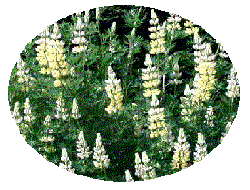 grows well in clay soils |
|
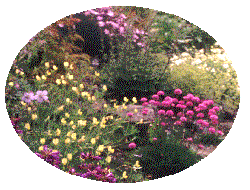 are suitable for most plants |
MEDIUM SOILS A soil with a mixture of clay, silt, sand and humus is often referred to as a loam. It contains the nutrients necessary for plants, holds sufficient water to make them available to the plant roots, with air pockets between the particles to allow good drainage, and it holds together well. Perhaps the easiest soil for gardening in, these fertile loamy soils are suitable for almost any type of plant without alteration. |
|
| LIGHT SOILS There are several types of soil which can be called light. Sandy soils contain a very high proportion of sand, which contains few plant nutrients. They easily dry out, when the surface layer is easily blown away. Sandy soils drain quickly and do not hold water. They are often acidic. Sandy soils can be improved by adding plenty of organic matter in the form of garden compost or farmyard manure to give body and encourage moisture retention. |
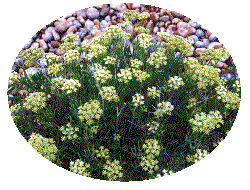 on sand and shingle beaches |
|
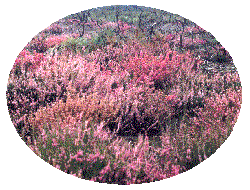 on moorland in the New Forest |
Peaty soils are also light. They often comprise almost solely peat, and often cover large areas of land, as in the New Forest or Dartmoor. Like sandy soils, they contain few plant nutrients. They are easily waterlogged, but can also dry out quickly. Peat soils may also contain a high percentage of fine sand, and they are acidic, supporting a small number of plant species that prefer these conditions. Peat forms the basis of soil-less composts, but needs the addition of fertilisers to provide plant nutrients. Peaty soil can be improved by the addition of garden compost or farmyard manure, and gravel or grit will help drainage. |
|
Chalky soils are also light. They are sometimes called basic soils. They are often very shallow, and they are always very alkaline. Chalk is a solid, soft rock which breaks down easily. It is very free draining, and chalky soils hold little water and dry out easily. They also tend to contain pieces of chalk, and often large flints, which should be treated with care, as they split easily and have very sharp edges. Chalky soils are fertile, but many of the nutrients are not available to plants because of the high alkalinity of the soil, which prevents the absorption of iron by plant roots. Chalky soils can be improved in so far as their physical structure is concerned, by the addition of humus to help retain water, but the alkalinity is almost impossible to alter, although sequestered iron sprinkled around individual plants may help them obtain the nutrients they need. |
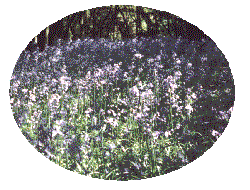 on the chalk of the North Downs |
|
Although we might like to provide the perfect soil for every plant in our garden, it is not feasible to change the soil we have. Although there are some plants which grow naturally in a particular soil, most plants will grow in a wide variety of conditions. It is useful to know roughly what sort of soil you have to work with, and there's a simple test to check your soil composition on this webpage. Kits to test your soil's pH are available at garden centres, and a book listing plants suitable for particular soil types will convince you that whatever your soil you have a huge variety of plants to choose from. Two which have photos and descriptions of hundreds of plants are Right Plant, Right Place by Nicola Ferguson (Simon & Shuster) and Choosing the Perfect Plant for every part of your Garden (aka Best Plants for Your Garden) by Susan Berry & Steve Bradley. The RHS also publish one called Plants for Places.
Links to Other Useful Websites
How to find out what sort of soil you have in your garden
All about soil from The Gardening Telegraph
The BBC Gardening website has lists of plants suitable for each soil type (clay, silt, sand, loam, acid, alkaline), with descriptions, photos and growing information. Only the lists for acid and alkaline soil are on the front page; you get to the other lists from links at the bottom of those lists.
